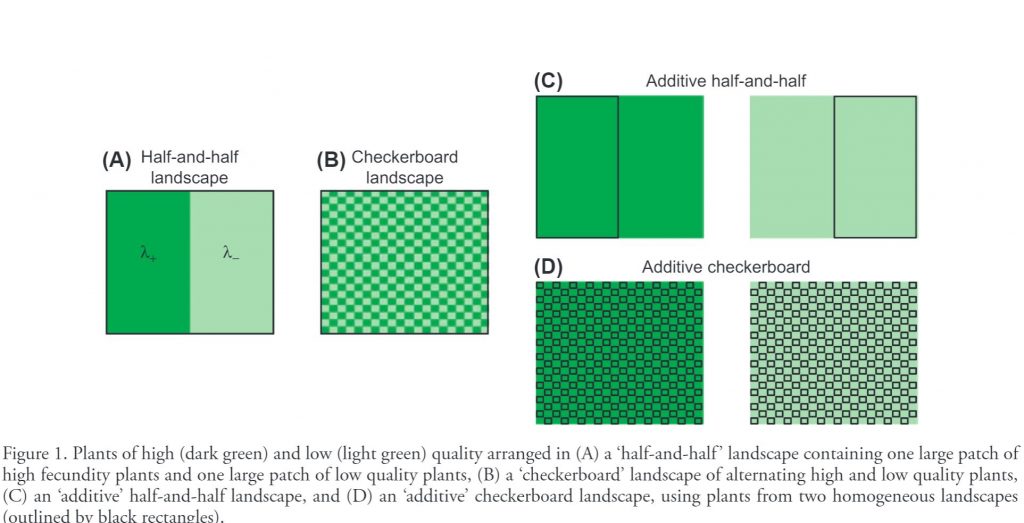Local variation in plant quality influences large-scale population dynamics.
Riolo, Maria A., Pejman Rohani, and Mark D. Hunter. “Local variation in plant quality influences large‐scale population dynamics.” Oikos 124.9 (2015): 1160-1170.
Riolo et al. consider the interaction of top-down parasitoid pressure and bottom-up heterogeneity in resource quality in driving spatial and temporal population dynamics of an herbivore. This study draws on a large prior body of work on spatially structured host-parasitoid dynamical models. The model has a few important specifications: 1) parasitoids disperse more rapidly than hosts, 2) populations within a patch are homogeneously mixed with a aHP parasitoid attacks in a given time step, 3) hosts diffuse uniformly while parasitoids move preferentially toward larger host populations, 4) patch networks are made up of high and low quality patches which have representatively different host growth rates, 5) mean quality was fixed and the difference between these two qualities was varied. Two different landscape types are con
sidered, 1) a half-and-half landscape in which all high quality patches are on one side of the network and all low quality patches on the other and 2) a checkerboard landscape in which high and low quality are alternated in space. These heterogeneous landscapes are compared to “additive landscape” counterparts which consider entirely low-quality patch and entirely high quality patch landscapes which are then sampled to observe the same patches that are of that quality in the landscape of interest. See figure. 2o simulations of 1000 generations were run for each scenario and only the last 200 generations were analyzed.
These simulations produce a number of interesting results. I will highlight a few here. In half-and-half landscapes populations oscillate much more quickly on high quality patches than on low quality patches, while the oscillations are far more similar on checkerboard landscapes. The ratio of parasitoids to hosts increased with increasing difference in patch quality in all scenarios but especially in checkerboard systems. Additionally temporal variance in both host and parasitoid populations increased with increasing difference in patch quality, though it remained lower in checker-board and additive checkerboard landscapes. In checkerboard landscapes high quality patches had lower parasitoid densities and low quality patches higher parasitoid densities than their counterpoints in the additive system. Host species, likely as a result, were much lower in low quality patches and somewhat higher in high quality patches than in an additive landscape. In half-and-half landscapes, the interface between low and high quality regions represents the main departure from an additive system. Low quality patches at this threshold have far fewer hosts while the high quality patches have higher host densities. These results were largely robust to parameter variation (retaining the assumption that parasitoids disperse more quickly than hosts) with the exception of the situation in which parasitoids do not preferentially disperse towards hosts. Under these circumstances checkerboard set-ups had substantially higher host densities than half-and-half and the host densities in checkerboards increased rapidly with the difference in patch quality (suggesting the necessity of this host seeking behavior for parasitoid mediated density suppression).
This work provides an important synthesis of two different and important population dynamic drivers and can serve as a conceptual and theoretical building block for understanding even more complexly structured environmental variation. The work is also applicable to agricultural pest systems providing predictions (and recreating observed dynamics) about the effects of large monocrop vs. intercropping systems.
